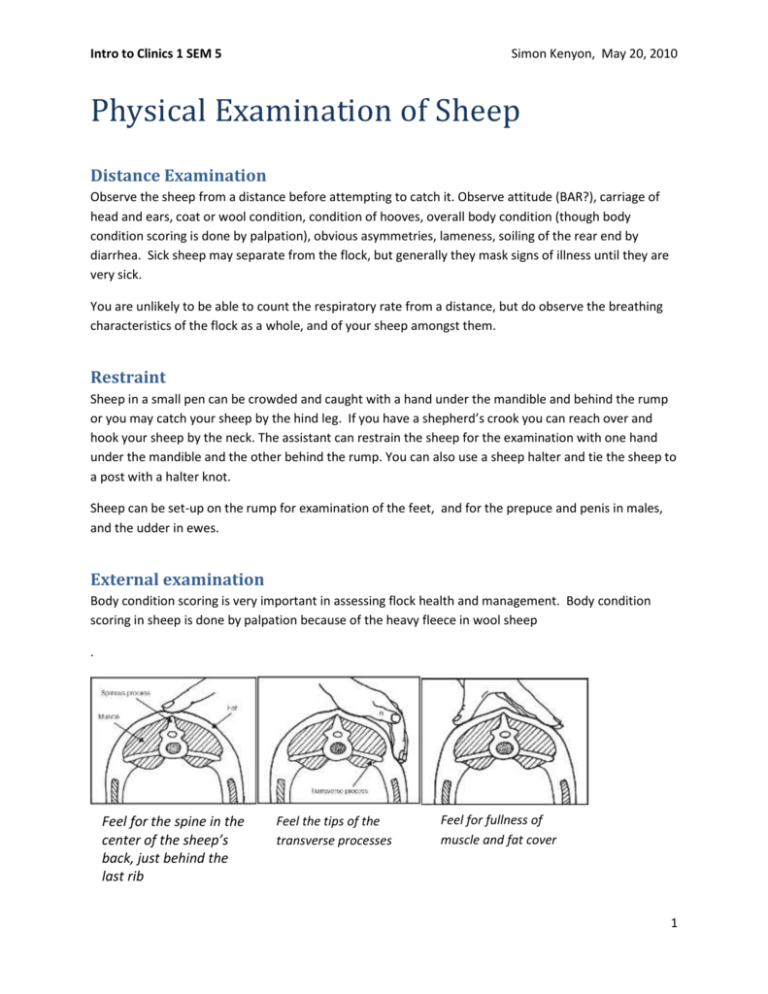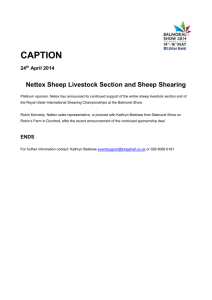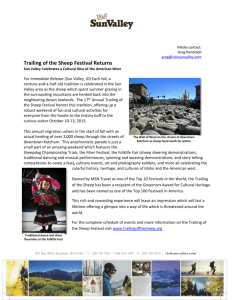Physical Examination of Sheep
advertisement

Intro to Clinics 1 SEM 5 Simon Kenyon, May 20, 2010 Physical Examination of Sheep Distance Examination Observe the sheep from a distance before attempting to catch it. Observe attitude (BAR?), carriage of head and ears, coat or wool condition, condition of hooves, overall body condition (though body condition scoring is done by palpation), obvious asymmetries, lameness, soiling of the rear end by diarrhea. Sick sheep may separate from the flock, but generally they mask signs of illness until they are very sick. You are unlikely to be able to count the respiratory rate from a distance, but do observe the breathing characteristics of the flock as a whole, and of your sheep amongst them. Restraint Sheep in a small pen can be crowded and caught with a hand under the mandible and behind the rump or you may catch your sheep by the hind leg. If you have a shepherd’s crook you can reach over and hook your sheep by the neck. The assistant can restrain the sheep for the examination with one hand under the mandible and the other behind the rump. You can also use a sheep halter and tie the sheep to a post with a halter knot. Sheep can be set-up on the rump for examination of the feet, and for the prepuce and penis in males, and the udder in ewes. External examination Body condition scoring is very important in assessing flock health and management. Body condition scoring in sheep is done by palpation because of the heavy fleece in wool sheep . Feel for the spine in the center of the sheep’s back, just behind the last rib Feel the tips of the transverse processes Feel for fullness of muscle and fat cover 1 Intro to Clinics 1 SEM 5 Simon Kenyon, May 20, 2010 Examination of Body Systems Physiologic parameters Rectal temperature Ruminations Pulse Respiration 101.8 – 104.0 ~2/minute 70-80/minute 12-20/minute 2 Intro to Clinics 1 SEM 5 Simon Kenyon, May 20, 2010 Cutaneous system – skin and hair coat Although the hooves are part of the cutaneous system it is usual to examine them at the end of the examination after setting the sheep on its rear end. Hair sheep tend to shed their coat in the spring of the year. They are less susceptible to “wool break” than wool sheep. Wool break is caused by nutritional or disease stress. Hair sheep under similar stress tend to develop dry, dandruff like flakes on the skin. Note changes in the hair coat and part the hair to examine the skin. Look for irritation caused by external parasites such as lice, ringworm and mange mites. These may manifest as pruritis, abscesses or pustules. Check particularly around the dew claws, a common site for chorioptic mange. Nervous system examination Nervous system abnormalities in sheep are often expressed as changes in gait, blindness, circling, head pressing, or facial nerve paralysis. Asymmetries as a result of muscle atrophy or nerve paralysis may be evident. Examination of the head It is convenient to examine the head at the beginning of the examination. Look for facial swellings or abscesses, and injuries caused by fighting, particularly in rams. Observe the face of the sheep for asymmetry – one drooping ear, ptosis, asymmetry of the muzzle, or evidence that it drops feed from the mouth. Examine the eyes for watery discharge, inflammation of the conjunctiva or keratoconjunctivitis. Note the color of the mucous membranes (expose the nictitans by depressing the globe of the eye with digital pressure on the eyelid). Note signs of anemia, jaundice or generalized congestion. Examine the lips and gums for vesicles, erosions or necrotic ulceration. Look for vesicles, pustules or scabs on the lips, nostrils, face and eyelids which are common sites for contagious ecthyma. Check the incisors –lost incisors (broken mouth) are a common cause of poor condition in older sheep. It is difficult to open a sheep’s mouth wide enough to examine the cheek teeth, but you should feel through the skin of the cheek for missing teeth. Estimate the age of the sheep from the dental chart. 3 Intro to Clinics 1 SEM 5 Simon Kenyon, May 20, 2010 Birth to 12 months, lamb’s teeth 12–19 months, two-tooth 18–24 months, four-tooth 23–36 months, six-tooth 28–48 months, eight-tooth Old sheep, broken mouth Digestive system Palpate the pharynx for evidence of injury or abscessation of lymph nodes. Listen to the rumen – 1-2 rumen contractions /minute are usual in sheep (cf cattle). Note the character of the feces. Respiratory system Slight serous nasal discharge may be present in normal sheep. Unilateral nasal discharge may be caused by nasal bots or other obstruction, and often induces sneezing. Bilateral purulent or bloody nasal discharge, or coughing, may indicate respiratory tract infection. Palpate trachea to see if a cough can be elicited. Auscultation of lung fields Cranial ventral border at 6th rib, mid thorax at 7th rib, caudal border at 11th rib. Sounds heard best in the trachea and at the base of the lungs. Inspiratory breath sounds are normally louder than expiratory sounds. Abnormal sounds are crackles (opening of closed airways) and wheezes (vibratory sounds in narrowed airways). 4 Intro to Clinics 1 SEM 5 Simon Kenyon, May 20, 2010 Cardiovascular system Heart sounds best heard in axilla between 2nd and sixth rib. Take care to push the head of the stethoscope under the elbow to listen to the cranial portion of the heart. Normal heart rhythm is regular (60-80 beats/minute). Two heart sounds (S1 & S2) are normally heard. The easiest place to take the pulse is the femoral artery on the medial aspect of the thigh. Evaluation of mucous membranes for color, state of hydration and capillary refill can be done on the buccal, conjunctival or vaginal membranes. Capillary refill time should be less than 2 seconds. Lymphatic system Sub-mandibular, pre-scapular and pre-femoral nodes should be palpated. Other lymph nodes may be palpable if enlarged. Genital system Ram testicles should be large, uniform in size, mobile within the scrotum, and firm. They should be palpated carefully for abnormalities (orchitis, epididymitis, adhesions etc). The urethral process should be visible at the end of the penis. Ewes may have normal reddish brown lochia at the vulva up to 3 weeks post-partum. Mammary Gland The halves of the udder should be symmetrical, pliable and of uniform temperature. Palpate carefully for abnormalities of consistency and check the skin of the udder and teats for lesions. Locomotor System Lameness is very common in sheep. Observe for carpal swellings, and palpate limbs for abnormalities such as epiphyseal swelling or joint inflammation. Examine the feet and pare away excess horn and underrun horn as part of your examination. Smell the feet! Footrot has a characteristic foul odor. 5 Intro to Clinics 1 SEM 5 Simon Kenyon, May 20, 2010 SHEEP PHYSICAL EXAM Clinician ____________________________ Student ____________________________ Temp ______Pulse _______Resp. _______Estimated Weight ________ Temperament _____ System Exam Check X if abnormal and describe below 1. □ General Appearance 6. □ Integumentary 10. □ Eyes 2. □ Cardiovascular 7. □ Urogenital 11. □ Ears 3. □ Respiratory 8. □ Gastrointestinal 12. □ Mucous Membranes 4. □ Nervous 9. □ Lymphatic 13. □ Oral Cavity 5. □ Musculo-skeletal Age (by dentition)_____________________ 14. □ Other Body Condition Score:___________________ At what anatomic location are the heart sounds most intense? Heart Rate? How many heart sounds? Sounds heard over trachea? (Inspiration, Expiration, Intensity) Sounds heard over lungs? Where are the lung sounds loudest? Frequency of rumen contractions: Which lymph nodes do you feel? Describe the pupils? Color of oral mucosa? Capillary Refill Time? ____________________________________________________ 6 Intro to Clinics 1 SEM 5 Simon Kenyon, May 20, 2010 Testicles: Size ___________ Mobility__________________ Consistency _________ 7







